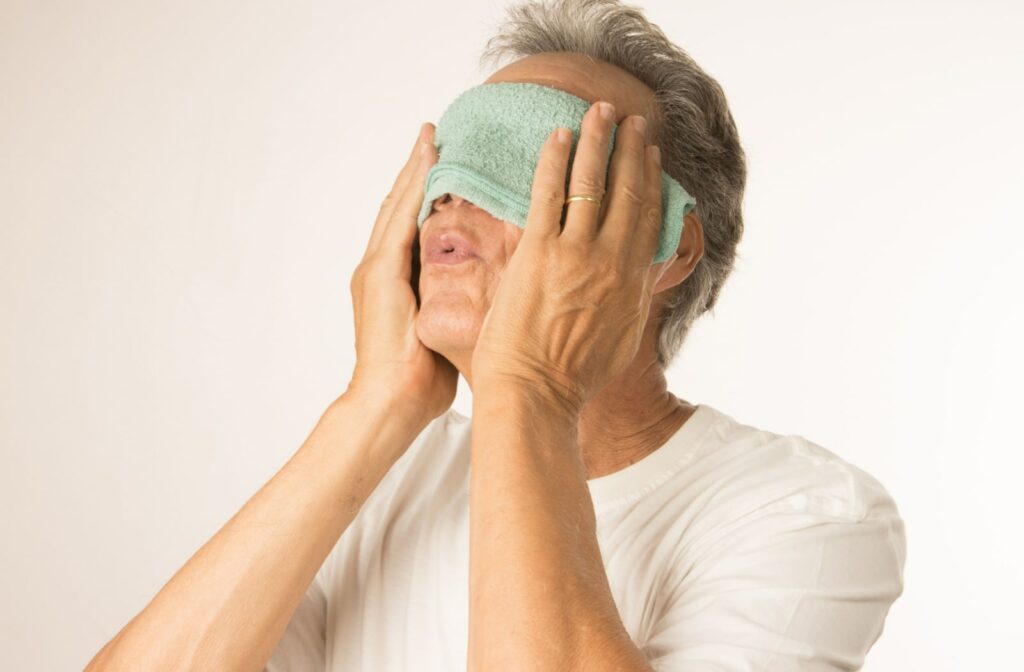Many eye conditions affect vision, comfort, and overall quality of well-being. Blepharitis is one such common condition.
Blepharitis is not contagious. However, a flare-up can be annoying and cause discomfort. Fortunately, there are several ways to manage and prevent blepharitis flare-ups.
What Is Blepharitis?
Blepharitis refers to the inflammation of the eyelids, particularly where the eyelash follicles are located. It commonly affects both eyelids and can lead to red, itchy eyelids and dandruff-like flakes along the eyelashes.
There are 2 different types of blepharitis:
- Anterior blepharitis: This occurs at the outside front edge of the eyelid where the eyelashes attach. It can be caused by bacteria or dandruff from the scalp and eyebrows.
- Posterior blepharitis: This affects the inner edge of the eyelid that touches the eye and is usually due to problems with the oil glands in the eyelid, leading to a condition known as meibomian gland dysfunction (MGD).
Symptoms & Causes of Blepharitis
Symptoms of blepharitis may include:
- Red or swollen eyelids
- Itchy eyelids
- Flaky skin around the eyes
- Burning sensation in the eyes
- Watery, sticky, or stringy discharge
Several factors may lead to blepharitis:
- Bacterial infection: Staphylococcal bacteria often live harmlessly on the skin, but if they become excessive, they can sometimes cause blepharitis.
- Dandruff from the scalp and eyebrows: This is also known as seborrheic dermatitis; dandruff flakes can irritate the eyes and cause inflammation.
- Meibomian gland dysfunction (MGD): This results from clogged or malfunctioning oil glands along the eyelids, creating a comfortable environment for bacterial growth.
- Lice or mites in eyelashes: These infestations can block eye glands and eyelash follicles along the eyelid.
Risk Factors for Developing Blepharitis
Several risk factors can increase an individual’s susceptibility to developing blepharitis:
- Skin conditions: Individuals with certain skin conditions, such as rosacea, eczema, or seborrheic dermatitis (dandruff), are at a higher risk of developing blepharitis. These conditions can affect the skin around the eyelids, leading to inflammation.
- Oily skin: People with oily skin are more prone to posterior blepharitis due to the potential for oil glands in the eyelids to become clogged or function improperly.
- Poor contact lens use: Improper contact lens use, such as overnight wear, extended wear, and improper cleaning and handling, can increase the risk of blepharitis.
- Medical conditions: Health issues that affect the immune system, such as diabetes, can make it easier for infections to develop, including those that lead to blepharitis.
- Poor eyelid hygiene: Not regularly cleaning the eyelids to remove dirt, oil, and makeup can lead to the development of blepharitis.
Understanding these risk factors is important for individuals at higher risk. Implementing preventive measures and maintaining good eyelid hygiene can help reduce the chances of developing blepharitis and its flare-ups.
Can you Catch Blepharitis From Someone?
A common concern is whether blepharitis is contagious. The answer is no; blepharitis is not a condition you can catch from someone else.
While it involves a bacterial infection, the bacteria are typically part of the skin’s microbiota and only cause issues when they multiply uncontrollably, or the eyelid area becomes irritated for other reasons.
How Is Blepharitis Treated?
The causes of blepharitis are varied but often stem from a bacterial infection, dysfunction of the eyelid oil glands, seborrheic dermatitis, or allergies. Understanding the underlying cause helps your optometrist develop the most suitable treatment for your ocular concern.
Blepharitis is a chronic condition that never fully goes away. Flare-ups can be managed to prevent the spread of bacteria or other irritants that can make the condition worse.
Leaving blepharitis untreated can lead to concerns such as:
- Chronic pink eye
- Corneal ulcer
- Eyelashes growing in the wrong direction
- Loss of Eyelashes
- Stye

Treatment & Prevention of Blepharitis
The treatment for blepharitis focuses on relieving symptoms, controlling inflammation, and managing any underlying conditions that may contribute to the problem.
Regularly cleaning your eyelids is fundamental in managing blepharitis. This can involve gently washing the eyelid margins with a warm, wet cloth and mild soap or baby shampoo. Your optometrist may recommend specific eyelid wipes to help remove debris or mite infestations.
Applying a warm compress to the eyes and massaging around the area for a few minutes several times a day can help loosen the oils in the blocked glands of the eyelids. This also helps to remove flakes or scales from along the lash line.
If blepharitis is caused by a bacterial infection, your optometrist may prescribe antibiotic ointments or drops applied directly to the eyelid margins. In severe cases, they may prescribe oral antibiotics. In some cases, blepharitis may be caused by a viral infection, and antibiotics won’t be a suitable form of treatment.
Using artificial tears can relieve the dryness associated with blepharitis. While they don’t target the underlying cause, they can provide relief from its symptoms.
During a blepharitis flare-up, avoid wearing makeup or contact lenses. These products may further irritate the eyes and cause the symptoms to linger. Practice proper contact lens wear and care, and take off your makeup every night to avoid eye irritation.
After a blepharitis flare-up, replace your contact lenses, contact lens case, and any eye makeup that may have come in contact with the bacteria to avoid cross-contamination.
Avoid touching or rubbing the eyes. Even if there’s no sign of blepharitis, minimize contact with your eyes to prevent irritation, and always wash your hands!
Book an Appointment in Regina
While blepharitis can be a persistent and annoying condition, understanding its causes, recognizing its symptoms, and adhering to a proper treatment plan can significantly alleviate discomfort and prevent future flare-ups.
If you’re experiencing symptoms of blepharitis, visit your optometrist. They can help develop a treatment plan suitable for your specific needs.
Connect with our team at Advance Eye Care Center to schedule your next eye exam appointment.





